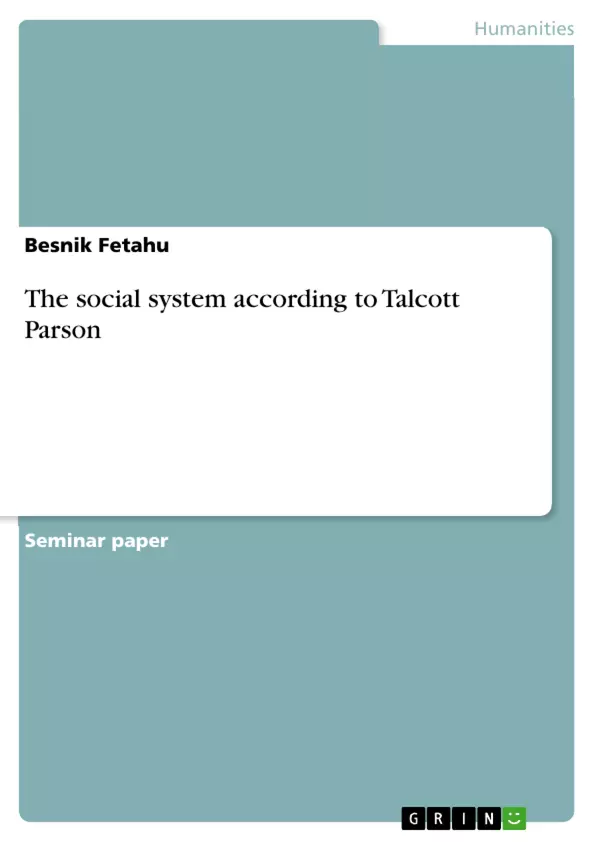In this paper the social system will be treated according to Talcott Parsons thought, always drawing attention to segments of the social system which he considers essential in welfare to the social process. His conclusion that society is essentially a complexity of parts in cooperation, proves his influence on the functionally approach, respectively Durkheim thoughts, however, Parsons was awarded a significant complexity to this approach. There are several reasons why Parsons ideas are important: First, they had an impact on American sociology and beyond; Second, incorporate these ideas into its own collision between individual shares of the individual and social system; Thirdly, this crash is ongoing and this is a fact that needs further study the social system; And finally Parsons ideas on the functioning of social system are provocative and descriptive. On the biggest, his ability is how to include the Durkheim ideas in his scheme.
Inhaltsverzeichnis (Table of Contents)
- Introduction
- What is functionalism?
- Macroperspective and microperspective
- Roles of individuals, who they play in societies sets the Parsons view for social meaning.
- Socialization as integrating force
- Social control as a mechanism
- Four systems by Talcott Parsons
- Cultural system
- Social System
- Personality System
- Behavior system
Zielsetzung und Themenschwerpunkte (Objectives and Key Themes)
This paper explores the concept of the social system according to Talcott Parsons, analyzing the key elements he considered essential for the functioning of society. It examines Parsons' influence on the functionalist approach and highlights the importance of understanding the interplay between individual actions and the social system.
- The concept of the social system as defined by Talcott Parsons
- The functionalist approach to understanding social phenomena
- The relationship between individual actions and the social system
- The role of socialization and social control in shaping individual behavior
- Parsons' identification of four interconnected systems: cultural, social, personality, and behavior
Zusammenfassung der Kapitel (Chapter Summaries)
- Introduction: This chapter provides a brief overview of Talcott Parsons' life and work, highlighting his significance as a social theorist and the influence of Bronislaw Malinowksy on his early thinking. It sets the stage for the paper's exploration of Parsons' concept of the social system.
- What is functionalism?: This chapter introduces the concept of functionalism as an approach to studying social phenomena. It explains the core principles of functionalism, emphasizing the interconnectedness of various societal components and their role in maintaining social equilibrium. This section also discusses the origins of the functionalist approach, highlighting the influence of Durkheim and Comte.
- Macroperspective and microperspective: This chapter differentiates between the macro and micro perspectives in sociological analysis. It explores the macro perspective's emphasis on social structures and its view of individuals as shaped by these structures. Conversely, the micro perspective focuses on individualism and subjectivity, viewing social structures as external influences on individuals.
- Roles of individuals, who they play in societies sets the Parsons view for social meaning.: This section discusses Parsons' perspective on social meaning, emphasizing the role of individuals within the social system. It highlights how the meaning of individual actions is shaped by the broader societal context and the values and norms of the social system.
- Socialization as integrating force: This chapter delves into the process of socialization as a key mechanism for integrating individuals into society. It explains how individuals learn and internalize the values and norms of their society through interactions with others, beginning from childhood and continuing throughout life.
- Social control as a mechanism: This section examines social control as a mechanism for maintaining social order and ensuring conformity to societal expectations. It discusses how social control operates through various means, including sanctions, social pressure, and formal institutions, to regulate individual behavior and prevent deviations from accepted norms.
- Four systems by Talcott Parsons: This chapter introduces Parsons' four systems: cultural, social, personality, and behavior. It explains how these systems interact and influence individual actions, with each system contributing to the overall functioning of society.
- Cultural system: This section focuses on the cultural system, highlighting the role of shared symbols and values in shaping individual behavior. It explains how cultural meanings and beliefs provide a framework for understanding and navigating social interactions.
- Social System: This section examines the social system, defined as the interaction of individuals within a network of roles and relationships. It emphasizes how social structures and expectations influence individual actions and maintain social order.
- Personality System: This chapter explores the personality system, which focuses on the needs, motivations, and attitudes of individuals. Parsons' analysis of the personality system aims to understand why individuals behave in certain ways under specific circumstances.
- Behavior system: This section examines the behavior system, which encompasses the physical and environmental aspects of human existence. It highlights Parsons' interest in the relationship between the environment and mental processes.
Schlüsselwörter (Keywords)
This preview delves into the theories of Talcott Parsons, focusing on the social system, functionalism, macro and micro perspectives, socialization, and social control. It also explores Parsons' concept of four interconnected systems: cultural, social, personality, and behavior, providing a comprehensive understanding of his sociological thought.
- Quote paper
- Besnik Fetahu (Author), 2010, The social system according to Talcott Parson, Munich, GRIN Verlag, https://www.grin.com/document/161389



